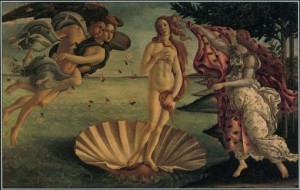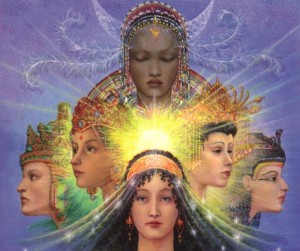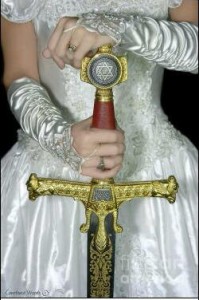What is above and beyond all things is so masculine that we are all feminine in relation to it. —C.S. Lewis, That Hideous Strength (1946)

Boticelli's The Birth of Venus
The Goddess Religions
Once upon a time there was a matriarchal society that stretched from Ireland to India. It worshipped the Goddess, the female spirit or principle immanent in the Earth. This society fostered love, peace, and ecological conscientiousness. It rejected economic exploitation, social hierarchy, and violence of all sorts. But then along came some marauding Indo-Europeans and Hebraic Semites. They overwhelmed the Goddess culture and exterminated or submerged any traces of its fundamental beliefs or ritual practices. Anything that remained had to go underground… for a very long time.
“Goddess” religions began to emerge from the shadows in the late Middle Ages. Christian society labeled its practitioners “witches” and tried to exterminate them. These were the “Burning Times,” the era of the Great Witch Hunt (c. 1480—1750). Christians thought these witches were in league with the devil, when in fact they were merely using their Earth magic to help the weak and bring joy to the oppressed. The magic was innocent. It was the witch hunters who were demonic. But the witch hunters had the upper hand, and so the Goddess religion again retreated underground for another century or so. Now, since the 1950s, it has risen in our midst to bring love, life, and healing to a violent, patriarchal culture ready to destroy itself.
Revising the Revision
The problem with this history is that it is pure invention. There is no documentary or archaeological evidence for this continent-wide Goddess culture. There is no evidence that the witchcraft of the late Middle Ages represented a single religion, let alone one dedicated to a single goddess. There is substantial evidence that the whole cult of the Goddess is a recent invention—as recent as the 1970s. Wicca predates it by all of twenty years. (See Ronald Hutton’s book, The Pagan Religions of the Ancient British Isles, Their Nature and Legacy, especially the last chapter.)
It should be obvious that a lot of Goddess fanciers don’t know their history. Religious necessity, however, is the mother of their invention and they do understand that myths can shape a culture.
 The Great Mother Goddess
The Great Mother Goddess
Of course, the ancient world had its goddesses. Some lands still do. Arguably, these goddesses could be seen, both historically and philosophically, as variations on or manifestations of one Mother Goddess. But the goddess was always in some way the counterpart of the god. The god represented the masculine side of nature and the goddess, the feminine. So Baal was the lightning and rain that impregnated Earth and Astarte (or Ashtoreth) was the fertile land that brought forth life in consequence. But both were purely immanent deities, forces or principles inherent in nature. As such, they were necessary corollaries, but neither was ever without the other.
The worship of “nature deities” was degrading and abominable. Ritual prostitution, self-castration, and child sacrifice were the magical tools by which worshipper and priest could force Nature to render up its benefits. Earth magic was not kind and gentle, nor was it life giving. It was violent and perverse. Scripture describes it as demonic (Deut. 32:17; 2 Chron. 11:15; Ps. 106:34-8; 1 Cor. 10:20-21).
Naming God
The God of Scripture is neither male nor female. He is pure Spirit. Yet He calls Himself “Father.” He uses masculine pronouns when He speaks of Himself. This is not an accident of grammar or an accommodation to Hebrew or Mediterranean culture. God’s revelation of Himself is true. The names He gives us are never arbitrary: God reveals Himself as He is. But the names He gives us are anthropomorphic and analogical.
…It is altogether impossible to say anything about God apart from the use of anthropomorphisms. We do not see God as he is in himself. We behold him in his works. We name him according to the manner in which he has revealed himself in his works (Bavinck, 91).
God uses human language, the language of the material creation, to reveal Himself. He is a Sun and Shield; a Shepherd and King; a Fountain, a Shadow, and a Rock. He has a strong arm and a voice like thunder. He must speak this way. If God were to speak to us in divine language, no one would be able to understand him. If He really wishes us to understand Him and know Him, He must speak to us in terms of the world we know, the world He created. All of this means that when God uses masculine titles and pronouns to refer to Himself, He is communicating real truth. God is “He” rather than “She”. “Father” rather than “Mother.”
The Masculine God
God created the universe as something distinct from Himself, but under His sovereign authority. He doesn’t share His life, His living essence, with creation in general or man in particular. He is not mother to humanity. He is Father. He is Lord.
Because God is “outside” His creation, humanity can’t know God by intuition or emotional experience. God must speak to His people if they are to know Him properly. The words that God speaks are truth and law. God expects us to understand those words, love them, and submit to them. We’re not going to find any deeper revelation of God’s will by looking deeper within ourselves. Intuition is no substitute for rationality and sentiment no substitute for obedience. Certainly God is love, but that love is always manifest in and works through His covenant with us. And His covenant always involves structure, order, and law as well understanding, submission, and obedience.
For Scripture then, God is masculine, though not male. He doesn’t exist biologically or sexually, but exists as the transcendent and sovereign Lord of creation. Given this, it may seem strange that Scripture very plainly ascribes to Yahweh, a bride. (Isa. 54:5; Jer. 31:32; Ps. 45)
Yahweh’s Bride
Yahweh’s bride is neither a cosmic deity nor a planetary spirit. She is neither the self-conscious universe nor some version of living Earth. Yahweh’s bride is redeemed humanity, the covenant people He is saving from

Constance Woods Warrior Bride Stand FineArtAmerica.com
sin. The New Testament calls this covenant people “the Church,” and it calls the Church “the Bride, the Lamb’s Wife” (Eph. 5:22-32; Rev. 21:9).
Perhaps it’s helpful to understand (in human terms) the gospel as a romance story and Jesus’ life and death as an active rescue mission. Jesus came to save His Bride. He loved the Church and gave Himself for it. (Eph. 5:25) That is, He gave Himself as an effective ransom for His people. He took on their moral guilt and bore God’s wrath in their place (1 Jn. 2:1; 4:10). He won their salvation in total (Matt. 1:21b). That salvation means forgiveness of sins, eternal life, and union with Christ through the indwelling Spirit of God. The same Spirit that indwells Christ without measure now indwells His Church as the living, existential bond of life and power between Bridegroom and Bride. In the context of Holy Communion and its significance, the Heidelberg Catechism (1563) says this:
76. Q. What is it to eat the crucified body and drink the shed blood of Christ?
A. It is not only to embrace with a believing heart all the sufferings and the death of Christ, and thereby to obtain the forgiveness of sins and life eternal, but, further, also to become more and more united to his sacred body, by the Holy Spirit, who dwells both in Christ and in us, so that, though Christ is in heaven and we are on earth, we are nevertheless flesh of his flesh and bone of his bones, and live and are governed by one Spirit, as members of the same body are by one soul.
The Catechism is echoing St. Paul. “For we are members of his body, of his flesh, and of his bones,” Paul says (Eph. 5:30): “…this is a great mystery.”
Imaging Yahweh’s Marriage
It is from this gospel mystery that Paul begins his discussion of biblical marriage. Jesus Christ—Yahweh incarnate—loved the Church and gave Himself for her (Eph. 5:25-29). The Church honors and submits to her self-sacrificing Lord (Eph. 5:22-24). This relationship is archetypical and authoritative. In other words, God expects humanity to imitate it. But the imitation is necessarily on a human level. The husband isn’t Christ: he isn’t God. His love is imperfect and finite. His wisdom is fallible and his authority is limited. Ontologically, he and his wife share the same created nature. Both have God as their primary reference point. (Gen. 1:26-28) Both exist for His glory. Both are truly and fully human yet made in the image of God.
But man is the masculine image of God, and woman is the feminine image. The differences between the two are real and more than simply biological. God made the man first, the woman afterwards from his genetic material (his rib). God made the man to exercise stewardship over His world and He made the woman to be her husband’s appropriate and necessary helper in this great task of stewardship (Gen. 2:18). This says nothing about the relative intelligence, talent, or moral character of the two. It merely establishes an order for godly work and family life, consistent with the way God created the partners.
Husband and Wife in Marriage
The man was created to relate first to God (worship) and then to the creation (stewardship). Within marriage, the man represents both himself and his wife to God. He is the covenant head of the home and its spiritual leader. And whether he whines about or not… the chief accountability is his. The woman was created to relate to God and then to her husband (“a suitable helper”—Gen. 2:18). Within marriage, the woman is to be a helper to her husband. She is to be his companion, advisor, and chief executive officer.
Scripture requires the man to nurture his wife, to help her grow in God’s word, and to love her sacrificially (1 Tim. 5:8; Eph. 5:25-33). He is to die daily to self for her spiritual and material well-being. Scripture requires the wife to reverence and submit to her husband (Eph. 5:22-24, 33; 1 Pet. 3:1-6). Her attitude toward her husband is to be one of respect for Jesus’ sake, not necessarily for his. We’re talking about mutual submission here (Eph. 5:21), and every married couple is probably going to have to work out the details differently.
Like God’s relationship with His own Bride, marriage is a covenant bond. What’s more, God Himself has sealed that bond. He intends marriage to last until death parts the married couple. Scripture recognizes only particular, grievous sins as legitimate grounds for divorce: fornication (sexual sin) and desertion (failure to live with one’s spouse in a godly manner) [Matt. 19:19; 1 Cor. 7:15]. He sums up His will toward marriage short and sweet in the seventh commandment from Sinai: “Thou shalt not commit adultery.”
The Ravages of Sin
In our age marriage has many enemies. Some men and women move from one marriage to another, selfishly seeking their own gratification on their own terms. Some degrade and abuse their spouses, either physically or emotionally. Some choose childless marriages, even if it means murdering their unborn children. Many pursue sex apart from marriage or outside their own marriages. Many reduce the sexual act to entertainment or worse. Many men enslave themselves to pornography. Many, like Jimmy Swaggart, act religiously in public and secretly visit prostitutes. Some men and women even try to reinvent gender and sexuality altogether.
But all attempts to redesign marriage and sexuality are inherently self-destructive. Marriage is rooted in the nature of God and in His covenant with His own Bride. When God said, “Thou shalt not commit adultery,” He was telling us about Himself, about His own faithfulness, love, and purity. He was teaching us how the world works and how our own natures work. He was giving us wisdom and showing us how to love… how to really love. But we need His grace to live up to the pattern. We need Jesus Christ, the Divine Bridegroom.
For Further Reading:
Ronald Hutton, The Pagan Religions of the Ancient British Isles, Their Nature and Legacy (Oxford: Blackwell, 1991).
Philip G. Davis, Goddess Unmasked, The Rise of Neopagan Feminist Spirituality (Dallas: Spence Publishing Company, 1998).
Herman Bavinck, The Doctrine of God (Edinburgh: The Banner of Truth Trust, 1991 reprint).
John Piper and Wayne Gruden, Recovering Biblical Manhood & Womanhood, A Response to Evangelical Feminism (Wheaton, IL: Crossway Books, 1991).
 Off The Grid News Better Ideas For Off The Grid Living
Off The Grid News Better Ideas For Off The Grid Living




